
University of Southern California presents 10 architecture student projects
[ad_1]
Dezeen School Shows: a playground that aims to encourage social exchange across the Mexico-United States border wall is included in this school show by students at University of Southern California.
Also included is an architectural system that imitates a sponge to store and release water sparingly and a cathedral informed by patterns found in nature.
Institution: University of Southern California
School: School of Architecture
Courses: Bachelor of Architecture, Master of Architecture, and Undergraduate and Graduate Programmes Final Thesis Studios
Tutors: Ryan Tyler Martinez, Lisa Little, Sascha Delz, Yaohua Wang, Marcos Sánchez, Mary Casper, Eric Haas, Wendy Fok and Evelyn Tickle
School statement:
“University of Southern California (USC) presents a selection of ten graduate and undergraduate architecture students’ award-winning final thesis projects.
“USC Architecture is a dynamic platform for educating and inspiring ‘citizen architects’ to analyse problems and create design solutions that both respond to the challenges of our time and embrace the promise of a better built environment.
“For 100 years, the USC Architecture faculty and graduates have pushed beyond the traditional boundaries of the field to pioneer many paradigm-shifting new practices of architecture.
“Deeply rooted in the city of Los Angeles, USA, and also intensely connected to global concerns, USC architects and scholars work shoulder to shoulder with our surrounding communities.
“They work together to develop, empower and leverage local insight that enables them to become intelligent and intrepid practitioners and forge creative solutions.
“From a foundation of rigorous research and inspired design, USC architects and scholars move fluidly from theory into practice.
“Embedded in one of the nation’s most respected research universities, the School of Architecture nurtures an environment in which students and faculty collaborate across disciplines.
“The result of this multidisciplinary approach to practice is that USC Architecture graduates are uniquely equipped to tackle the complexities of the built environment and bring new meaning to a tradition of great design.”
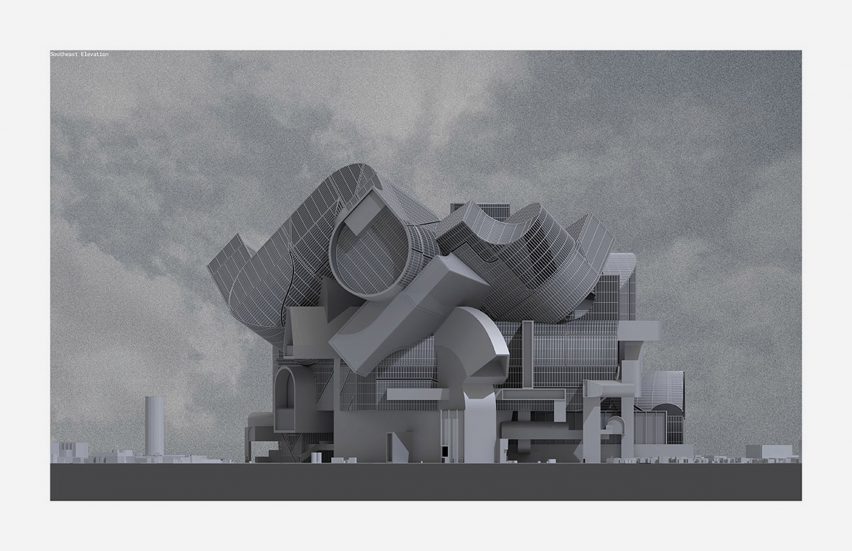
Post-Heroism: Towards a Formalism Methodology of Foreseeing Urbanism by Fangshuo Zhao
“This research project delves into the notion of ‘enormity’ as a catalyst for a paradigm shift in contemporary architecture, specifically within the context of the transition from heroism to post-heroism.
“Heroism emerged as a dominant architectural paradigm in the 20th-century, emphasising the heroic role of the architect and their grand gestures.
“However, as societal realities have evolved, the limitations of heroism have become apparent, necessitating a new architectural language capable of addressing the complexities of the modern world.
“This study explores the evolving relationship between old and new heroism, considering the decline of social democracy and the rise of populism and neoliberalism as influential factors.
“Post-heroism emerges as a formalism index for this new architectural approach. It acknowledges the limitations of heroism and embraces a more inclusive and collaborative stance.
“By integrating ‘enormity’ and the public thermae model, post-heroism provides a framework for architecture that balances individual expression with the collective needs of society.”
Student: Fangshuo Zhao
Course: ARCH 793B Buildings, Drawings, Objects, and Aesthetics
Tutor: Ryan Tyler Martinez
Award: Master of Architecture Excellence in Directed Design Research in recognition of the most outstanding graduate final degree project illustrating a critical position that advances the discourse of the architectural discipline

Composing Persona by Francesca Picard
“In this thesis, architecture is explored through the lens of persona. What if buildings are just as much characters in the built environment as the people who occupy them?
“This study will explore two main determinants of a building’s persona – form and materiality. The form is seen as the body of a building characterised by its frame, posture and overall presence.
“Just as we define characters by their physique, buildings are defined by their form – materiality offers another layer of characterisation to a building through properties of patterns, colours and textures.
“With collage serving as a method of working and a nod to the exploration of intertextuality, it can be used to create compositions of both form and materiality.
“These resulting personas will be ‘asked’ to interact with each other just as buildings are ‘asked’ to communicate with their surrounding contexts.
“Through this exploration, a dialogue on persona in architecture can develop.”
Student: Francesca Picard
Course: ARCH 793B Buildings, Drawings, Objects, and Aesthetics
Tutor: Ryan Tyler Martinez
Email: francesca.a.picard[at]gmail.com
Award: Master of Architecture Disciplinary Advancement in Directed Design Research Award
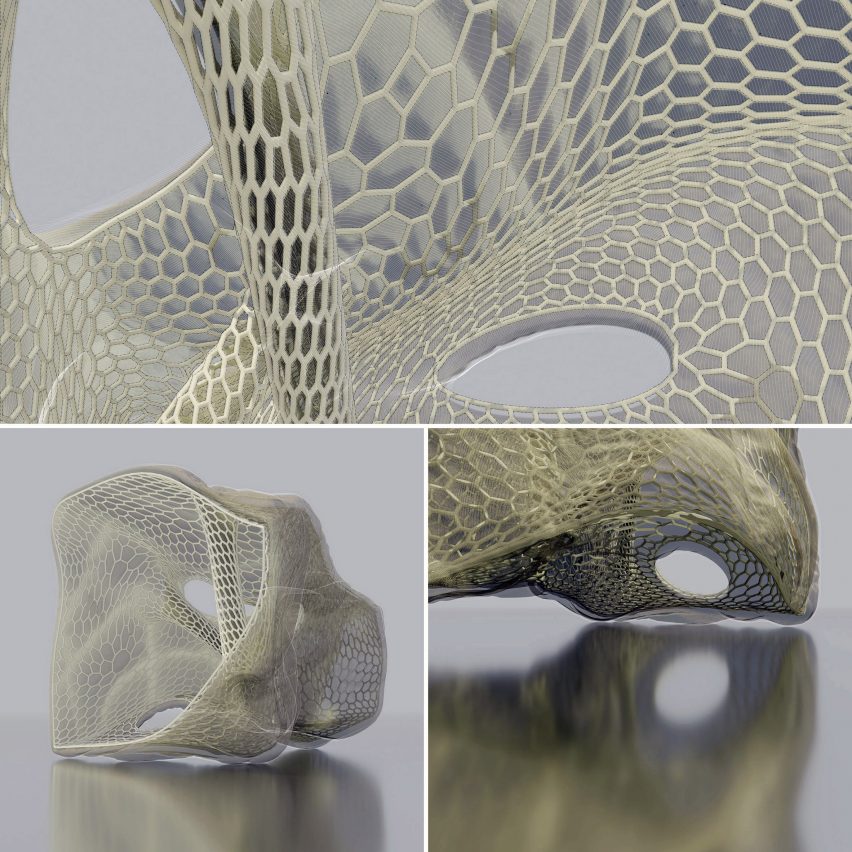
Water-Wise Wrapper by Debdeep Dam
“Modern city-making has been oriented towards over-engineered city planning without regard for ecosystems or context as modern urban environments have always had access to uncontested water resources.
“The modern city treats stormwater as a nuisance, as something to be drained away and out of sight even though water scarcity has become such a prominent issue.
“Architectural systems for water conservation, collection, cleaning and reuse try to mitigate this – these systems should be adopted by all buildings.
“With the increasing commodification of clean and potable water as well as the gross exploitation of this natural resource, it has become imperative to explore options for equally and fairly using, storing and distributing it.
“Water-Wise Wrapper attempts to bring this crucial subject to the forefront of urban living while advocating for a system that can leverage the vast vertical landscapes of the modern city.
“It acts as a sponge, absorbing water and releasing it as needed and serving as a visual representation of the scarcity of this vital resource.”
Student: Debdeep Dam
Course: ARCH 793B Critical Computation
Tutor: Lisa Little
Award: Master of Architecture Innovation in Directed Design Research Award in recognition of the most outstanding graduate final degree project illustrating technological innovation and advancement
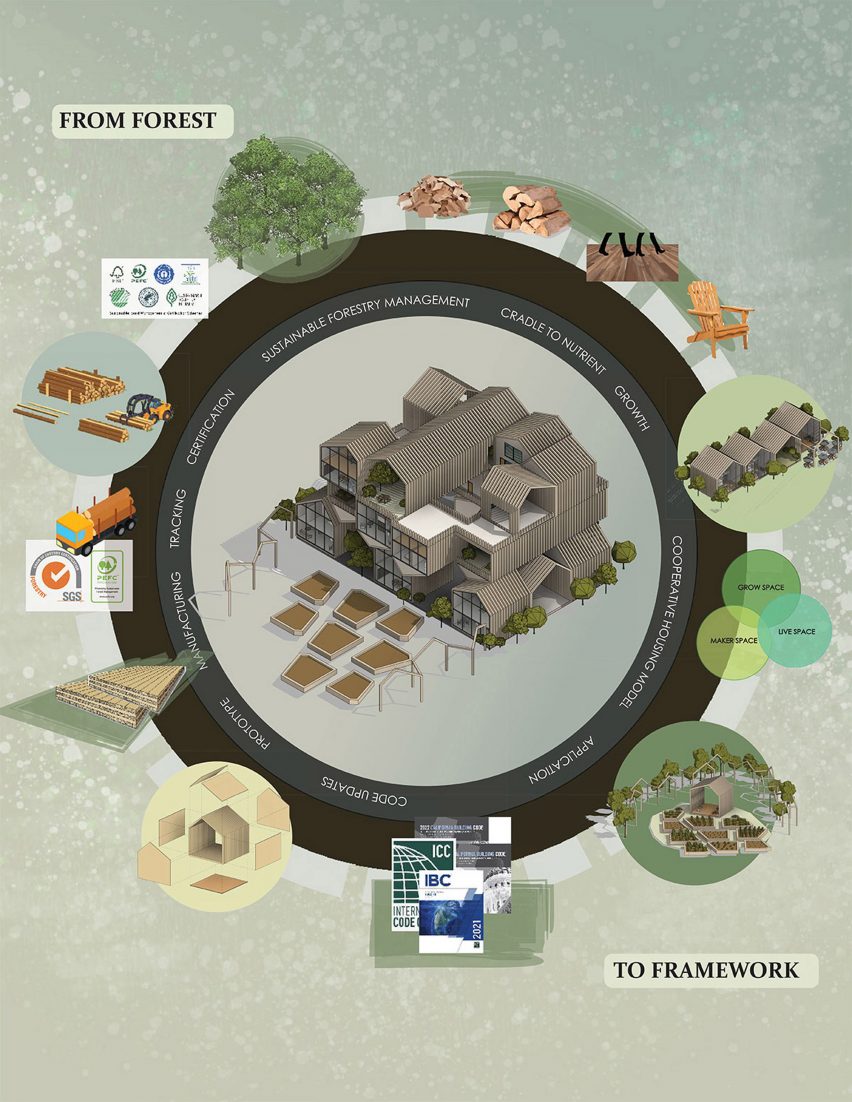
From Forest to Framework by Eleanor Selzer
“With the construction industry accounting for roughly 40 per cent of all global carbon emissions, a clear and vast opportunity exists within the architectural and construction industry to enact real change in fighting the climate crisis.
“This change, as seen from a top-down perspective within the supply chain, could include material substitutions, technology innovation and implementation as well as an independence from non-renewable energy sources.
“This project seeks to redesign the framework of sustainably harvested mass timber products, showing how they can be utilised in design practices to maximise flexibility, incremental growth, reuse and adaptability.
“This framework is applied to an affordable housing cooperative model located in Venice Beach in Los Angeles, USA, comprised of flexible and deconstructable mass timber modules.”
Student: Eleanor Selzer
Course: ARCH 793BL Directed Design Research
Tutor: Sascha Delz
Award: Master of Architecture Social and Environmental Dimensions in Directed Design Research Award in recognition of the most outstanding graduate final degree project exploring social, cultural and environmental concerns
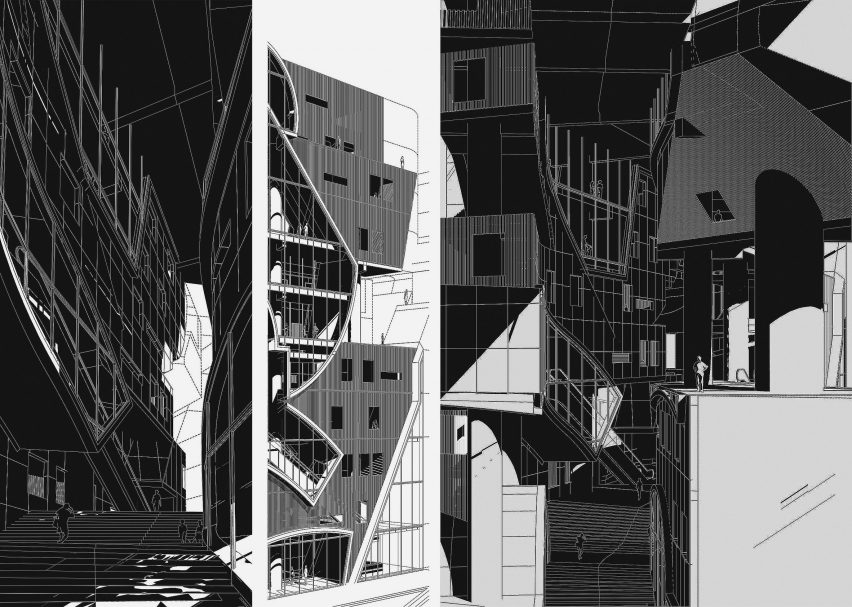
Dream Together and Miscellaneous Mutations by Brandon Smith
“Dream Together is a large-scale mixed-use project that uses imaginative forms to highlight the uniqueness of each citizen that interacts with it.
“In addition, the project aims to resolve the housing and urban sprawl issues in Los Angeles, USA, while challenging the tradition of the structure in which commercial spaces occupy the lower floors and residential spaces occupy the upper floors.
“This allows programmes to spread evenly throughout the building rather than simply stacking them in layers, adding to its humanistic residential qualities that are commonly seen in the programmatic zoning of a home.
“Dream Together acknowledges culture, moulding architectural typological conventions to adequately react to its surroundings. It orients, subtracts and protrudes itself based on key urban resources such as schools, grocery stores, religious centres or hospitals.
“Miscellaneous Mutations features these elements differently, dictated purely by aesthetics and formal discovery.
“This second part of the project encourages the discussion of revisiting a design that is perceived as finished and celebrates the saying that design never stops.”
Student: Brandon Smith
Course: ARCH 793BL Directed Design Research
Tutor: Yaohua Wang
Award: Master of Architecture Design Communication in Directed Design Research Award in recognition of the most outstanding graduate final degree project illustrating advanced presentation and graphic communication
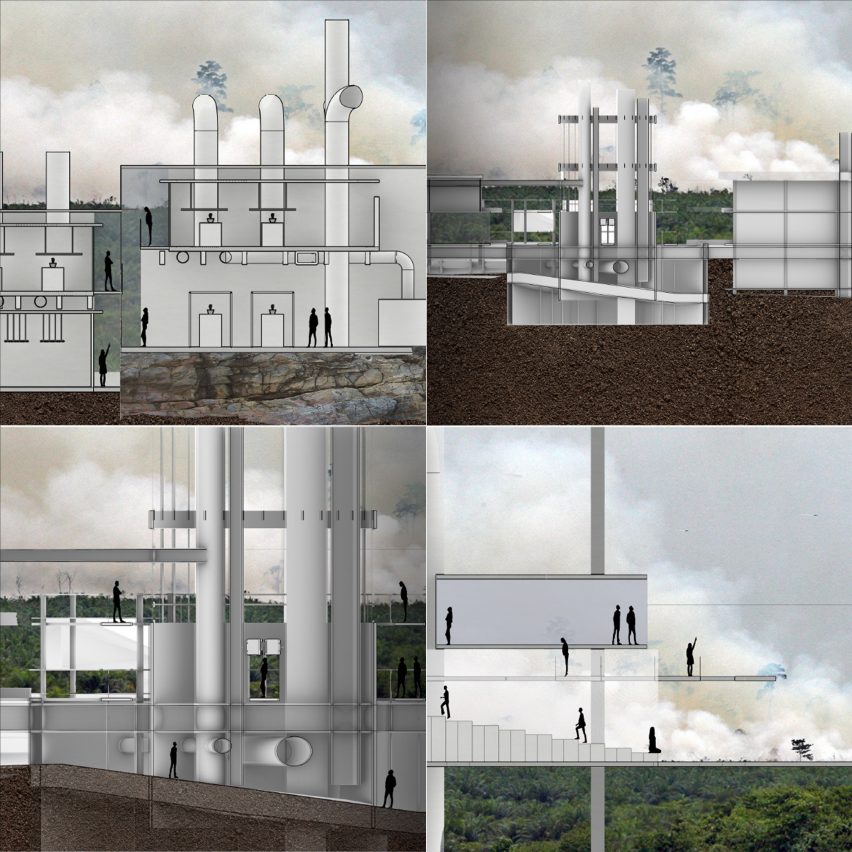
Companions in Conflict: Occupying the Intertwined Landscapes of Sumatra, Indonesia by Ian Leung
“The United Nations Educational, Scientific and Cultural Organisation (UNESCO) Tropical Rainforest Heritage of Sumatra, Indonesia, is one of the major biosphere reserves in the world, fuelled by neocolonialist attitudes.
“International agribusiness institutions, such as Wilmar International, have catalysed the industrial exploitation of palm oil, resulting in mass deforestation that has endangered the natural landscape.
“This project proposes an overlap where a border is shared between UNSECO and agribusiness institutions. For UNESCO, the project is of incalculable value, becoming more valuable over time and over generations – it is a form of management and preservation.
“On the other hand, for Wilmar International, it represents a form of hyper-productivity as they prioritise the ability to produce a product rather than a static management within an ecosystem.”
Student: Ian Leung
Course: ARCH 502A Undergraduate Thesis Studio Proving Ground: UNESCO’s Laboratories
Tutor: Marcos Sánchez
Email: ianzyleung[at]gmail.com
Award: Thomas Byerts Social and Community Design Award in recognition of outstanding final degree project involving social and/or community service
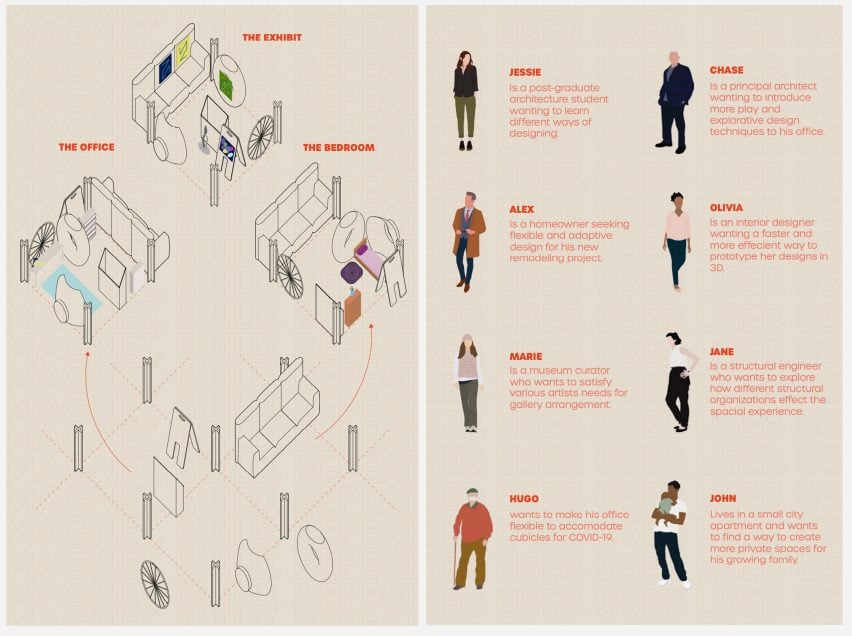
A. Malgam by Sophia Sabini-Leite
“This project explores an alternative methodology for practicing architecture and design. I began by acknowledging that current architectural education and practices remain strictly within regulated parameters.
“This ‘square’ thinking limits the possibilities of design. The question then arises, what if there was a method of practicing architecture that was not self-stabilising?
“Or, what if there was a method that did not need to address all problems of a design prior to engaging in the design process? Would this make the design process more of an ad hoc approach that begs interaction, play and exploration on the part of both the architect and the user?”
Student: Sophia Sabini-Leite
Course: ARCH 502A Undergraduate Thesis Studio: Representative Interiority
Tutor: Mary Casper
Award: Studio Culture Award in recognition of the student who contributed positively to the studio culture throughout the five-year professional Bachelor of Architecture programme
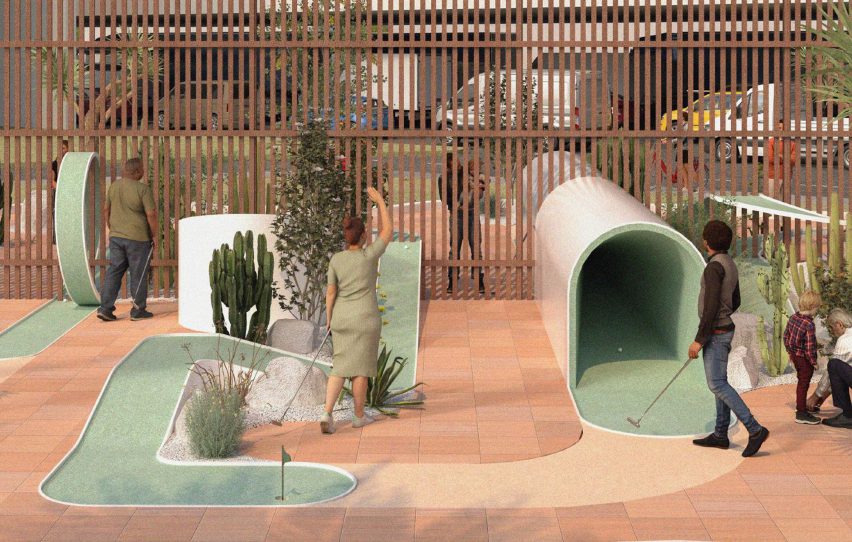
Insurgent Border Wall Architecture by Diana Alejandra Pérez
“The USA and Mexico border wall stands as a panoptic mechanism of separation and control.
“However, this proposal playfully challenges its intended impermeability through insurgent design operations, activating binational human exchange.
“Leveraging architecture as a tool of resistance, this project focuses on six urban sites at Port of Entry (POE) cities.
“It creates a network of subversive structures – a playground, taco spot, library, amphitheater, mini golf course and butterfly refuge.
“By destabilising the wall’s vertical cantilever, the proposal envisions a future where collaboration defies division, transforming the border into a site of shared experiences that transcend imposed boundaries.”
Student: Diana Alejandra Pérez
Course: ARCH 502B Adaptive M Isuse
Tutor: Eric Haas
Award: Design Studio Award in recognition of the undergraduate student who demonstrated design excellence throughout the five-year professional degree with the highest design GPA
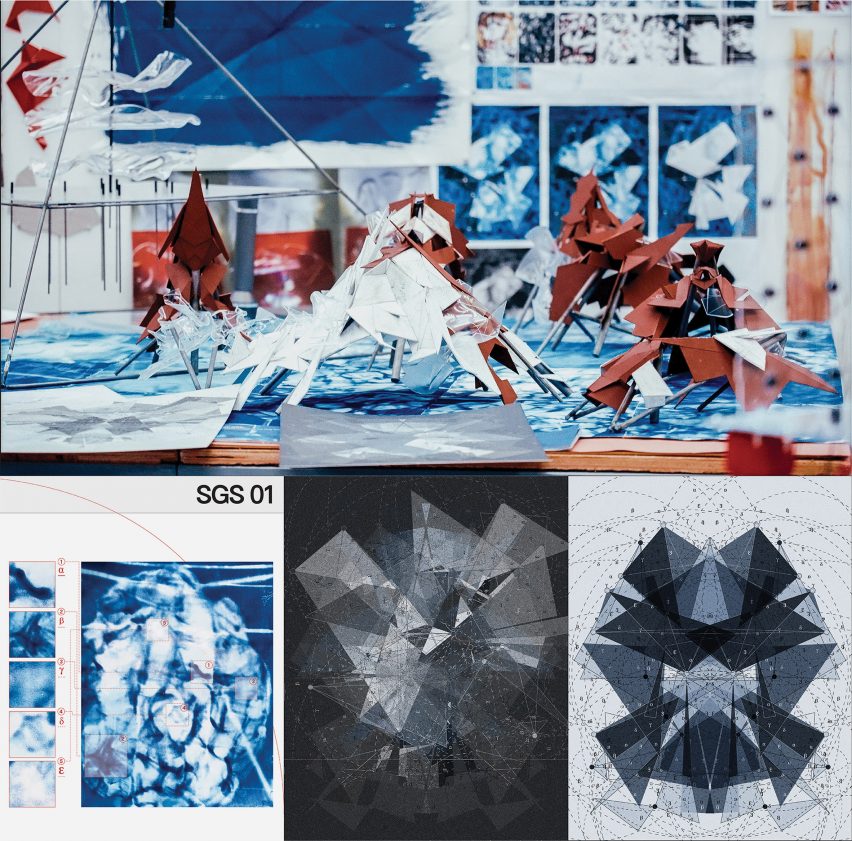
The Hand of God: Uncovering the Connection Between Form and the Soul by Drake Velasco
“As the central component of all things, fractals showcase the infinite complexity of material form, revealing repeating patterns found in all organic structures.
“To better understand God in nature, I studied how natural forms tend towards three principles of essence: symmetry, clarity and completeness.
“I observed how these principles align with doctrines of aesthetic beauty before using this knowledge towards the creation of a cathedral.
“This process led me to use fractals to generate a light patterning device that produces cyanotypes.
“The cyanotypes are then transformed into diagrams to convey the modelling of structures that have been ‘guided’ by the hand of God.”
Student: Drake Velasco
Course: ARCH 502A Undergraduate Thesis Studio
Tutor: Evelyn Tickle
Award: final degree undergraduate thesis project that is most exemplary in Architectural Delineation
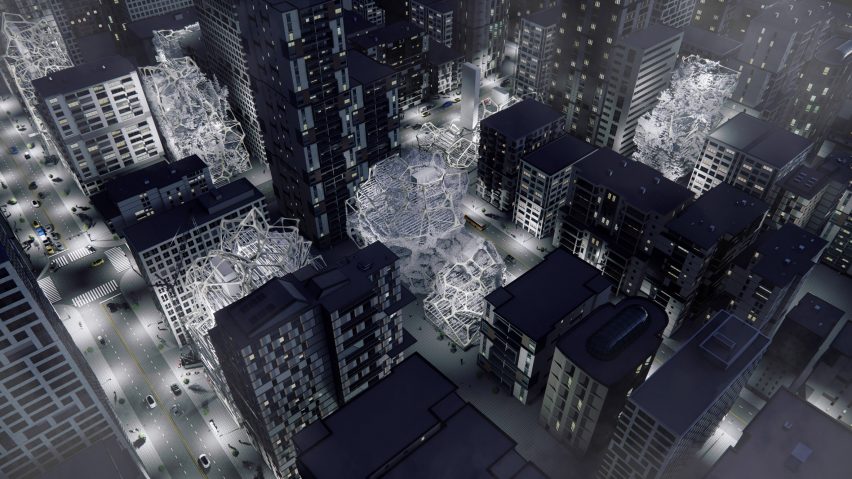
Limits of Nature by Thomas Wang
“In architecture’s current stride towards a sustainable built future, the contemporary human-led, top-down design approach is subject to exploitation and error.
“It undermines the path to a truly sustainable future where the human environment replicates and thrives harmoniously with the natural environment as emphasised by many visionary architects such as Étienne-Louis Boullée.
“Such vision minimises human involvement in designing basic structural building elements, such as frames and joists, and maximises natural material, such as crystals.
“Innate knowledge of the most efficient organisation, growth, adaptation and evolution schemes that have been time tested for billions of years fill in the walls and floors of the building.
“By taking advantage of nature’s wisdom, both humans and the natural environment can strive to exist symbiotically in a coherently sustainable and evolving world.”
Student: Thomas Wang
Course: ARCH 502A Hidden Infrastructures
Tutor: Wendy Fok
Award: Final Degree Project Award in recognition of the undergraduate student who produced the overall best final degree project
Partnership content
This school show is a partnership between Dezeen and University of Southern California. Find out more about Dezeen partnership content here.
[ad_2]





